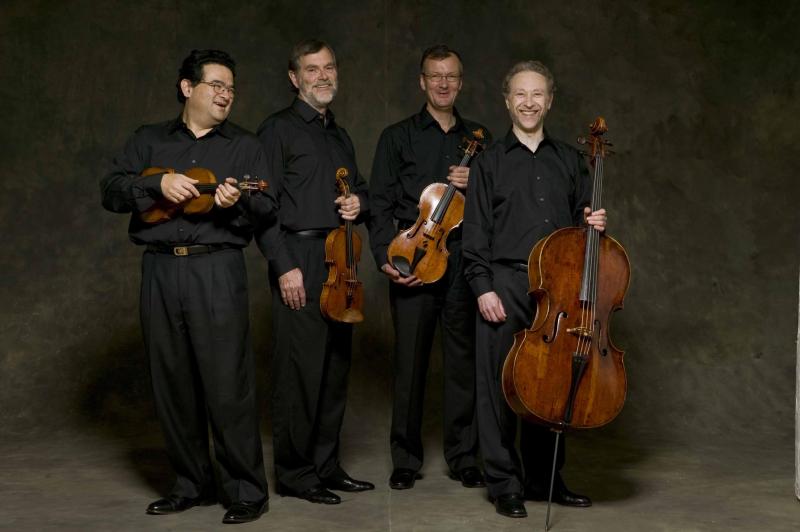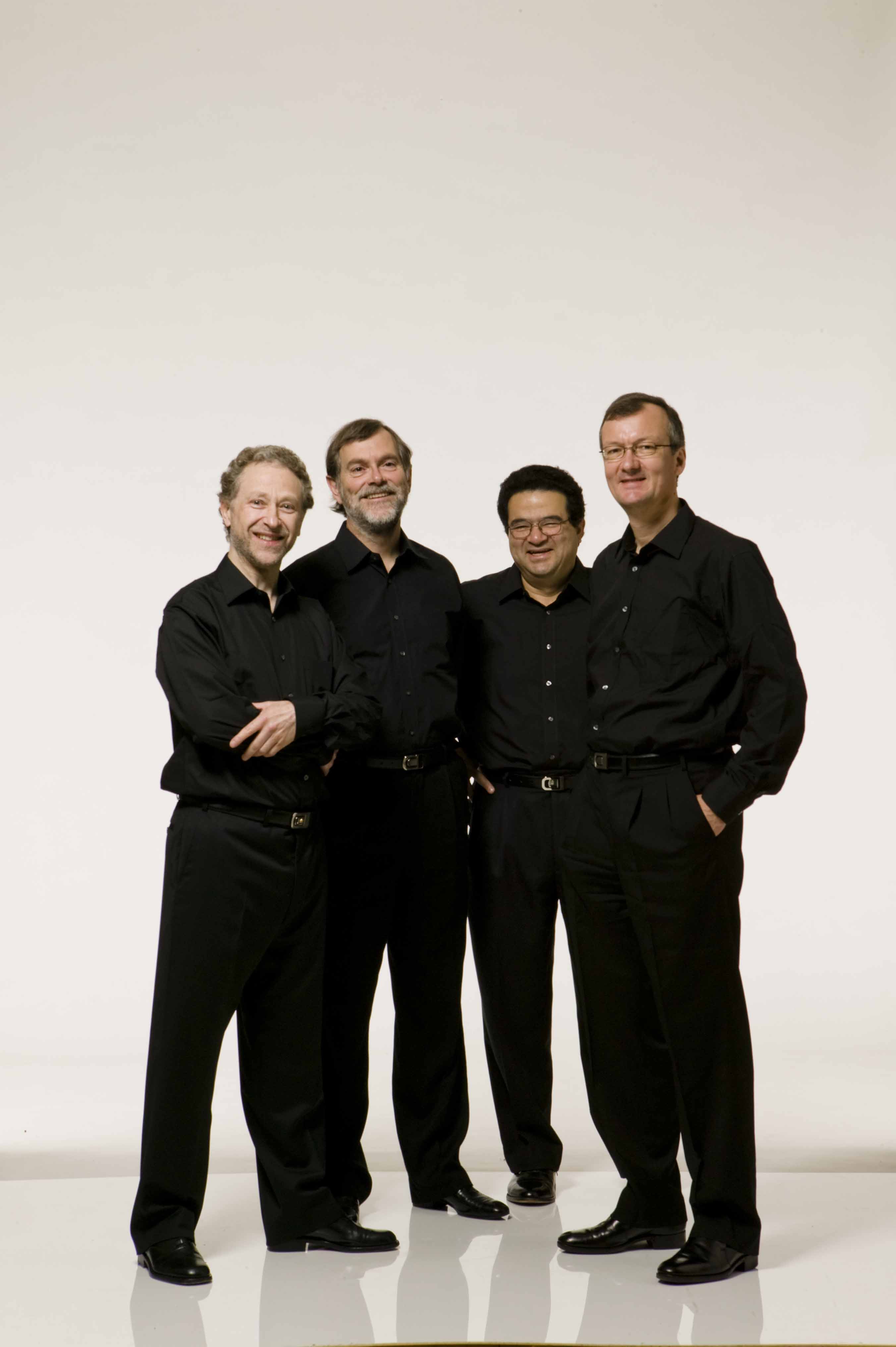Endellion Quartet, Wigmore Hall review - four decades of excellence | reviews, news & interviews
Endellion Quartet, Wigmore Hall review - four decades of excellence
Endellion Quartet, Wigmore Hall review - four decades of excellence
Britain's premier string quartet celebrate in - serious - style

The Endellion Quartet first rehearsed on 20 January 1979, deep in the throes of Britain’s so-called “Winter of Discontent”. That longevity – with three of the original players still on the team after four decades – makes the acclaimed ensemble roughly as old as Spandau Ballet, and senior to REM.
At 40, they now match the greatest age attained by the Amadeus Quartet – that band of immortals whose heavenly timbre sometimes comes to mind when you hear the Endellions. To shine as they should, they need the right setting, and the generously responsive acoustic of the Wigmore Hall has now hosted their richly intelligent music-making on – so cellist David Waterman said in a first-half speech – something like 100 occasions. He also remarked to a rousing cheer that, as you age, not only do the policemen appear young. Especially at the present moment, prime ministers and presidents start to look more “juvenile” than ever.
For their birthday gig, the Endellions typically programmed not a buffet of pleasing trifles but a substantial three-course meal which allowed them not a second for celebratory coasting. For starters, Haydn’s Op. 74 G minor Quartet – the “Rider” – cantered out of the stalls with an engaging mix of playfulness and gravitas. Soon enough the tender togetherness of the Endellion sound shone through, with Waterman’s cello – as throughout the evening – in the role of genial but rock-solid sheet-anchor. In the ravishing largo, Garfield Jackson’s honeyed viola soared and brooded, while an almost-stately minuet announced that this band has no need of breakneck tempos to make any cheap musical point. In the finale, suitably con brio, first violin Andrew Watkinson led a sort of nocturnal gallop in which the frolicsome syncopations of the scoring never quite threw off a hint of panic and chaos. The darkness and daring that the Endellions consistently find in Haydn looked forward to their restless exploration of the evening’s concluding work: Beethoven’s Op. 131 in C sharp minor.
 Before we came to Haydn’s greatest musical progeny, however, we took a highly relevant detour into the shadowed and even spooky sonic landscape of Bartok’s Second Quartet. Composed in 1915-17, the work in its strenuous and haunting sonorities leaves no wiggle-room, and no place to hide, for any voice in the quartet. All sang out with the brooding intensity Bartok commands, with the lower strings especially resonant in the anguished passages that fill the moderato first movement. After that, the scherzo-like allegro is a fanciful and mesmerising creation, rooted in the composer’s 1913 field-trip in North Africa. Bartok packs it with driving, hypnotic motifs that recall some trance-like gnawa ritual stretching deep into the night under a desert moon. Whether in the delirious unison passages, the crazy glissandi or stabbing pizzicato breaks, the Endellions delivered with a fierce commitment that went far beyond “orientalist” scene-painting. After this head-spinning excitement, the lento conclusion hits like a post-dawn comedown, comfortless and becalmed. The writing here eschews all showing off to leave each part naked and solitary; again, the Endellions brought lustre to the downer and passed Bartok’s test with flying, if muted, colours.
Before we came to Haydn’s greatest musical progeny, however, we took a highly relevant detour into the shadowed and even spooky sonic landscape of Bartok’s Second Quartet. Composed in 1915-17, the work in its strenuous and haunting sonorities leaves no wiggle-room, and no place to hide, for any voice in the quartet. All sang out with the brooding intensity Bartok commands, with the lower strings especially resonant in the anguished passages that fill the moderato first movement. After that, the scherzo-like allegro is a fanciful and mesmerising creation, rooted in the composer’s 1913 field-trip in North Africa. Bartok packs it with driving, hypnotic motifs that recall some trance-like gnawa ritual stretching deep into the night under a desert moon. Whether in the delirious unison passages, the crazy glissandi or stabbing pizzicato breaks, the Endellions delivered with a fierce commitment that went far beyond “orientalist” scene-painting. After this head-spinning excitement, the lento conclusion hits like a post-dawn comedown, comfortless and becalmed. The writing here eschews all showing off to leave each part naked and solitary; again, the Endellions brought lustre to the downer and passed Bartok’s test with flying, if muted, colours.
Only after the interval, as the Op. 131 quartet began, did the logic of the evening’s sequence really come into focus. Given the first-half selection, we could hear how Beethoven’s late masterwork not only builds on the past innovations of Haydn. It begins to open up dazzlingly fresh harmonic vistas that subsequent giants – Bartok not least among them – would extend and exploit. The Bach-like fugue began the work in a serene, otherworldly mood – with Waterman’s cello again as master of ceremonies – before a magic chromatic shift into the allegro, with its folksy bounce and lilt. In the half-dozen variations of the great andante theme, the Endellions seized the opportunity to showcase both individual flair and collective synchrony. One played for all, and all for one, as the four musketeers moved from the opening exchange between Andrew Watkinson’s and Ralph de Souza’s violins to the soulful viola-and-cello to-and-fro in the aptly marked “lusinghiero” – “seductive” third variation, with its shattering climax of wayward trills.
In the wild galop of the fifth, presto movement, the Endellions (pictured above) let us hear the joyful, slightly manic, laugh of Haydn’s delighted ghost. Ravishing lyricism from the violins in the bridging adagio prepared the way for a final allegro that, in its questing interrogations of the work's opening fugue, avoided any hint of smug or smooth closure. To the last gasp, the Endellions’ four discrete and distinct voices pointed up contrasts and tensions rather than wrapping things up in a bland birthday bow. As a celebration concert, this anniversary bash had its serious – though never solemn – side. But the guests of honour inscribed their virtues of alertness, mutuality and integrity over every page. That was quite thrilling enough.
rating
Share this article
Add comment
The future of Arts Journalism
You can stop theartsdesk.com closing!
We urgently need financing to survive. Our fundraising drive has thus far raised £49,000 but we need to reach £100,000 or we will be forced to close. Please contribute here: https://gofund.me/c3f6033d
And if you can forward this information to anyone who might assist, we’d be grateful.

Subscribe to theartsdesk.com
Thank you for continuing to read our work on theartsdesk.com. For unlimited access to every article in its entirety, including our archive of more than 15,000 pieces, we're asking for £5 per month or £40 per year. We feel it's a very good deal, and hope you do too.
To take a subscription now simply click here.
And if you're looking for that extra gift for a friend or family member, why not treat them to a theartsdesk.com gift subscription?
more Classical music
 Robin Holloway: Music's Odyssey review - lessons in composition
Broad and idiosyncratic survey of classical music is insightful but slightly indigestible
Robin Holloway: Music's Odyssey review - lessons in composition
Broad and idiosyncratic survey of classical music is insightful but slightly indigestible
 Bizet in 150th anniversary year: rich and rare French offerings from Palazzetto Bru Zane
Specialists in French romantic music unveil a treasure trove both live and on disc
Bizet in 150th anniversary year: rich and rare French offerings from Palazzetto Bru Zane
Specialists in French romantic music unveil a treasure trove both live and on disc
 Scottish Chamber Orchestra, Ibragimova, Queen’s Hall, Edinburgh review - rarities, novelties and drumrolls
A pity the SCO didn't pick a better showcase for a shining guest artist
Scottish Chamber Orchestra, Ibragimova, Queen’s Hall, Edinburgh review - rarities, novelties and drumrolls
A pity the SCO didn't pick a better showcase for a shining guest artist
 Kilsby, Parkes, Sinfonia of London, Wilson, Barbican review - string things zing and sing in expert hands
British masterpieces for strings plus other-worldly tenor and horn - and a muscular rarity
Kilsby, Parkes, Sinfonia of London, Wilson, Barbican review - string things zing and sing in expert hands
British masterpieces for strings plus other-worldly tenor and horn - and a muscular rarity
 From Historical to Hip-Hop, Classically Black Music Festival, Kings Place review - a cluster of impressive stars for the future
From quasi-Mozartian elegance to the gritty humour of a kitchen inspection
From Historical to Hip-Hop, Classically Black Music Festival, Kings Place review - a cluster of impressive stars for the future
From quasi-Mozartian elegance to the gritty humour of a kitchen inspection
 Shibe, LSO, Adès, Barbican review - gaudy and glorious new music alongside serene Sibelius
Adès’s passion makes persuasive case for the music he loves, both new and old
Shibe, LSO, Adès, Barbican review - gaudy and glorious new music alongside serene Sibelius
Adès’s passion makes persuasive case for the music he loves, both new and old
 Anja Mittermüller, Richard Fu, Wigmore Hall review - a glorious hall debut
The Austrian mezzo shines - at the age of 22
Anja Mittermüller, Richard Fu, Wigmore Hall review - a glorious hall debut
The Austrian mezzo shines - at the age of 22
 First Person: clarinettist Oliver Pashley on the new horizons of The Hermes Experiment's latest album
Compositions by members of this unusual quartet feature for the first time
First Person: clarinettist Oliver Pashley on the new horizons of The Hermes Experiment's latest album
Compositions by members of this unusual quartet feature for the first time
 Gesualdo Passione, Les Arts Florissants, Amala Dior Company, Barbican review - inspired collaboration excavates the music's humanity
At times it was like watching an anarchic religious procession
Gesualdo Passione, Les Arts Florissants, Amala Dior Company, Barbican review - inspired collaboration excavates the music's humanity
At times it was like watching an anarchic religious procession
 Classical CDs: Camels, concrete and cabaret
An influential American composer's 90th birthday box, plus British piano concertos and a father-and-son duo
Classical CDs: Camels, concrete and cabaret
An influential American composer's 90th birthday box, plus British piano concertos and a father-and-son duo
 Cockerham, Manchester Camerata, Sheen, Martin Harris Centre, Manchester review - re-enacting the dawn of modernism
Two UK premieres added to three miniatures from a seminal event of January 1914
Cockerham, Manchester Camerata, Sheen, Martin Harris Centre, Manchester review - re-enacting the dawn of modernism
Two UK premieres added to three miniatures from a seminal event of January 1914
 Kempf, Brno Philharmonic, Davies, Bridgewater Hall, Manchester review - European tradition meets American jazz
Bouncing Czechs enjoy their Gershwin and Brubeck alongside Janáček and Dvořák
Kempf, Brno Philharmonic, Davies, Bridgewater Hall, Manchester review - European tradition meets American jazz
Bouncing Czechs enjoy their Gershwin and Brubeck alongside Janáček and Dvořák

Comments
Huge thanks to Boyd Tonkin